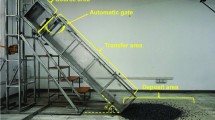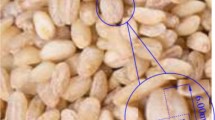Abstract
The large-volume and high-speed channelized granular flows transformed from energetic rockslides and rockfalls are serious geological disasters. The submerged sills embedded in the bedrock and immersed in a granular flow are widely used as a prevention measure in the midstream and downstream of the gullies due to their advantages of high shear resistance, good energy dissipation, and easy cleaning. However, the influence of the geometric characteristics of the submerged sill on the energy dissipation of the granular flow is still not elucidated. Herein, the volume-, velocity-, and runout-reduction effects of the granular flow by the different geometric submerged sill (rectangular, triangular, and cambered) and the geomorphic characteristics of the deposit were studied through physical modeling tests and numerical simulation tests. The results show that: (1) the rank of energy dissipation capacity of submerged sills with different shapes follows the order of cambered > rectangular > triangular; (2) the height of the submerged sill can facilitate the energy dissipation and velocity reduction, especially when the height increases to nearly the depth of the flow; (3) the energy consumption in the interaction process can be attributed to the friction between the particles and sill, the friction between the subsequent mobile particle and stagnant one on the dead zone, and the enhanced collision of the particles during the overflow. The research could provide helpful guidance for disaster prevention and mitigation of channelized granular flow in mountainous areas.
















Similar content being viewed by others
Data Availability
The data that support the findings of the study are available on request from the corresponding author.
References
Armanini A, Larcher M, Odorizzi M (2011) Dynamic impact of a debris flow against a vertical wall. Ital J Eng Geol Env 1:2011. https://doi.org/10.4408/IJEGE.2011-03.B-113
Bi Y, Du Y, He S et al (2018) Numerical analysis of effect of baffle configuration on impact force exerted from rock avalanches. Landslides 15:1029–1043. https://doi.org/10.1007/s10346-018-0979-z
Bi Y, Sun X, Zhao H et al (2021) Comparison regarding the effects of different baffle systems as impacted by rock avalanches. Int J Civ Eng 19:127–144. https://doi.org/10.1007/s40999-020-00557-w
Chen X, You Y, Chen J et al (2014) Characteristics of a drainage channel with staggered indented sills for controlling debris flows. J Mt Sci 11:1242–1252. https://doi.org/10.1007/s11629-013-2917-9
Chen J, Chen X, Chen H, Zhao W (2016) Characteristics of viscous debris flow in a drainage channel with an energy dissipation structure. J Mt Sci 13:223–233. https://doi.org/10.1007/s11629-014-3290-z
Chen J, Chen X, Zhao W, You Y (2018) Debris flow drainage channel with energy dissipation structures: experimental study and engineering application. J Hydraul Eng 144:06018012. https://doi.org/10.1061/(ASCE)HY.1943-7900.0001523
Choi CE, Goodwin SR (2020) Interaction between granular flows and flexible obstacles: a grain-scale investigation. Comput Geotech 128:103800. https://doi.org/10.1016/j.compgeo.2020.103800
Choi CE, Ng CWW, Song D et al (2014) Flume investigation of landslide debris–resisting baffles. Can Geotech J 51:540–553. https://doi.org/10.1139/cgj-2013-0115
Choi CE, Ng CWW, Law RPH et al (2015) Computational investigation of baffle configuration on impedance of channelized debris flow. Can Geotech J 52:182–197. https://doi.org/10.1139/cgj-2013-0157
Choi CE, Cui Y, Liu LHD et al (2017) Impact mechanisms of granular flow against curved barriers. Géotech Lett 7:330–338. https://doi.org/10.1680/jgele.17.00068
Crosta GB, Frattini P, Fusi N (2007) Fragmentation in the Val Pola rock avalanche. Italian Alps J Geophys Res 112:F01006. https://doi.org/10.1029/2005JF000455
Doan T, Indraratna B, Nguyen TT, Rujikiatkamjorn C (2023) Interactive role of rolling friction and cohesion on the angle of repose through a microscale assessment. Int J Geomech 23:04022250. https://doi.org/10.1061/(ASCE)GM.1943-5622.0002632
Faug T (2021) Impact force of granular flows on walls normal to the bottom: slow versus fast impact dynamics. Can Geotech J 58:114–124. https://doi.org/10.1139/cgj-2019-0399
Gong S, Zhao T, Zhao J et al (2021) Discrete element analysis of dry granular flow impact on slit dams. Landslides 18:1143–1152. https://doi.org/10.1007/s10346-020-01531-2
Goodwin GR, Choi CE (2020) Slit structures: fundamental mechanisms of mechanical trapping of granular flows. Comput Geotech 119:103376. https://doi.org/10.1016/j.compgeo.2019.103376
Hákonardóttir KM, Hogg AJ, Jóhannesson T, Tómasson GG (2003) A laboratory study of the retarding effects of braking mounds on snow avalanches. J Glaciol 49:191–200. https://doi.org/10.3189/172756503781830692
Hooke RL, Iverson NR (1995) Grain-size distribution in deforming subglacial tills: role of grain fracture. Geology 23:57. https://doi.org/10.1130/0091-7613(1995)023%3c0057:GSDIDS%3e2.3.CO;2
Huang Y, Zhang B (2022) Challenges and perspectives in designing engineering structures against debris-flow disaster. Eur J Environ Civ En 26:4476–4497. https://doi.org/10.1080/19648189.2020.1854126
Huang Y, Zhang B, Zhu C (2021) Computational assessment of baffle performance against rapid granular flows. Landslides 18:485–501. https://doi.org/10.1007/s10346-020-01511-6
Hutter (1993) Motion of a granular avalanche in a convex and concave curved chute: experiments and theoretical predictions. Phil Trans R Soc Lond A 342:573–600. https://doi.org/10.1098/rsta.1993.0033
Itasca Consulting Group Inc (2014) PFC3D: particle flow code in 3 dimensions (version 5.0) Manual. Itasca Consulting Group Inc, Minneapolis, USA
Iverson RM, Logan M, Denlinger RP (2004) Granular avalanches across irregular three-dimensional terrain: 2. Experimental tests. J Geophys Res-Earth 109. https://doi.org/10.1029/2003JF000084
Jiang YJ, Towhata I (2013) Experimental study of dry granular flow and impact behavior against a rigid retaining wall. Rock Mech Rock Eng 46:713–729. https://doi.org/10.1007/s00603-012-0293-3
Law RPH, Choi CE, Ng CWW (2016) Discrete-element investigation of influence of granular debris flow baffles on rigid barrier impact. Can Geotech J 53:179–185. https://doi.org/10.1139/cgj-2014-0394
Li WC, Li HJ, Dai FC, Lee LM (2012) Discrete element modeling of a rainfall-induced flowslide. Eng Geol 149–150:22–34. https://doi.org/10.1016/j.enggeo.2012.08.006
Li X, Yan Q, Zhao S et al (2020) Investigation of influence of baffles on landslide debris mobility by 3D material point method. Landslides 17:1129–1143. https://doi.org/10.1007/s10346-020-01346-1
Li K, Wang Y-F, Lin Q-W et al (2021) Experiments on granular flow behavior and deposit characteristics: implications for rock avalanche kinematics. Landslides 18:1779–1799. https://doi.org/10.1007/s10346-020-01607-z
Li K, Cheng Q, Lin Q, Wang Y et al (2022) State of the art on rock avalanche dynamics from granular flow mechanics. Earth Sci-J China Univ. Geosci 47:893. https://doi.org/10.3799/dqkx.2021.169
Luo G, Chen X, Zhang Q et al (2023) Failure mechanism and sedimentary characteristics of a catastrophic rockslide avalanche induced by the 2008 Wenchuan earthquake. Landslides 20:25–38. https://doi.org/10.1007/s10346-022-01955-y
Morino C, Conway SJ, Balme MR et al (2019) Debris-flow release processes investigated through the analysis of multi-temporal LiDAR datasets in north-western Iceland. Earth Surf Proc Land 44:144–159. https://doi.org/10.1002/esp.4488
Ng CWW, Choi CE, Song D et al (2015) Physical modeling of baffles influence on landslide debris mobility: baffle physical modeling influence on landslide debris mobility. Landslides 12:1–18. https://doi.org/10.1007/s10346-014-0476-y
Ng CWW, Choi CE, Liu LHD et al (2017) Influence of particle size on the mechanism of dry granular run-up on a rigid barrier. Géotech Lett 7:79–89. https://doi.org/10.1680/jgele.16.00159
Ng CWW, Majeed U, Choi CE, De Silva WARK (2021) New impact equation using barrier Froude number for the design of dual rigid barriers against debris flows. Landslides 18:2309–2321. https://doi.org/10.1007/s10346-021-01631-7
Ng CWW, Liu H, Choi CE et al (2022) Effects of basal clearance on the impact dynamics of dry granular flow against dual rigid barriers. Can Geotech J 59:1161–1174. https://doi.org/10.1139/cgj-2020-0682
Ng CWW, Jia Z, Poudyal S et al (2023) Two-phase MPM modelling of debris flow impact against dual rigid barriers. Géotechnique 1–14. https://doi.org/10.1680/jgeot.22.00199
Santi PM, Hewitt K, VanDine DF, Barillas Cruz E (2011) Debris-flow impact, vulnerability, and response. Nat Hazards 56:371–402. https://doi.org/10.1007/s11069-010-9576-8
Sanvitale N, Bowman ET (2017) Visualization of dominant stress-transfer mechanisms in experimental debris flows of different particle-size distribution. Can Geotech J 54:258–269. https://doi.org/10.1139/cgj-2015-0532
Scaringi G, Fan X, Xu Q et al (2018) Some considerations on the use of numerical methods to simulate past landslides and possible new failures: the case of the recent Xinmo landslide (Sichuan, China). Landslides 15:1359–1375. https://doi.org/10.1007/s10346-018-0953-9
Shen W, Zhao T, Zhao J et al (2018) Quantifying the impact of dry debris flow against a rigid barrier by DEM analyses. Eng Geol 241:86–96. https://doi.org/10.1016/j.enggeo.2018.05.011
Shugar DH, Jacquemart M, Shean D et al (2021) A massive rock and ice avalanche caused the 2021 disaster at Chamoli, Indian Himalaya. Science 373:300–306. https://doi.org/10.1126/science.abh4455
Taberlet N, Richard P, Valance A et al (2003) Superstable granular heap in a thin channel. Phys Rev Lett 91:264301. https://doi.org/10.1103/PhysRevLett.91.264301
Tyler SW, Wheatcraft SW (1992) Fractal scaling of soil particle-size distributions: analysis and limitations. Soil Sci Soc Am J 56:362–369. https://doi.org/10.2136/sssaj1992.03615995005600020005x
Vagnon F (2020) Design of active debris flow mitigation measures: a comprehensive analysis of existing impact models. Landslides 17:313–333. https://doi.org/10.1007/s10346-019-01278-5
Wang F, Chen X, Chen J, You Y (2017) Experimental study on a debris-flow drainage channel with different types of energy dissipation baffles. Eng Geol 220:43–51. https://doi.org/10.1016/j.enggeo.2017.01.014
Wang D, Li Q, Bi Y, He S (2020) Effects of new baffles system under the impact of rock avalanches. Eng Geol 264:105261. https://doi.org/10.1016/j.enggeo.2019.105261
Wang D, Bi Y, Li Q, He S (2021) Kinetic response analysis of different types of baffle submitted to rock avalanches based on discrete element method. Environ Earth Sci 80:600. https://doi.org/10.1007/s12665-021-09864-4
Xu Q, Shang Y, van Asch T et al (2012) Observations from the large, rapid Yigong rock slide – debris avalanche, southeast Tibet. Can Geotech J 49:589–606. https://doi.org/10.1139/t2012-021
Zhang B, Huang Y (2022) Effect of unsteady flow dynamics on the impact of monodisperse and bidisperse granular flow. Bull Eng Geol Environ 81:77. https://doi.org/10.1007/s10064-022-02573-7
Zhang B, Huang Y, Lu P, Li C (2020) Numerical investigation of multiple-impact behavior of granular flow on a rigid barrier. Water 12:3228. https://doi.org/10.3390/w12113228
Zhang B, Huang Y, Liu J (2021) Micro-mechanism and efficiency of baffle structure in deceleration of granular flows. Acta Geotech 16:3667–3688. https://doi.org/10.1007/s11440-021-01290-x
Zhang S, Yin Y, Li H et al (2022) Transport process and mechanism of the Hongshiyan rock avalanche triggered by the 2014 Ludian earthquake, China. Landslides 19:1987–2004. https://doi.org/10.1007/s10346-022-01878-8
Acknowledgements
The authors gratefully acknowledge support from the National Key R&D Program of China (2022YFC3005704), the National Natural Science Foundation of China (42277143, 42107155), and the Science and Technology Project of Science and Technology Department of Sichuan Province (2021YJ0033). The authors also thank the editors and anonymous reviewers for their constructive comments that improved the manuscript.
Author information
Authors and Affiliations
Corresponding author
Ethics declarations
Competing interests
The authors declare no competing interests.
Rights and permissions
Springer Nature or its licensor (e.g. a society or other partner) holds exclusive rights to this article under a publishing agreement with the author(s) or other rightsholder(s); author self-archiving of the accepted manuscript version of this article is solely governed by the terms of such publishing agreement and applicable law.
About this article
Cite this article
Luo, G., Chen, W., Shen, W. et al. Influence of submerged sill on the deposition and energy dissipation of granular flow. Bull Eng Geol Environ 82, 242 (2023). https://doi.org/10.1007/s10064-023-03269-2
Received:
Accepted:
Published:
DOI: https://doi.org/10.1007/s10064-023-03269-2




